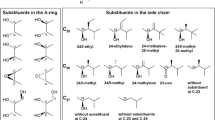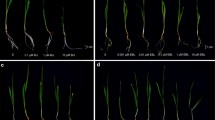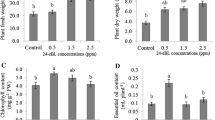Abstract
Brassinosteroids play an important role in growth and development of plants. They have been reported universally in all the plants. The present study deals with the presence of these compounds in immature tea seeds. Five brassinosteroids, i.e. 6-deoxo-28-norcathasterone, 6-deoxo-28-norteasterone, 3-dehydro-6-deoxo-28-norteasterone, 6-deoxo-28-nortyphasterol and 6-deoxo-28-norcastasterone have been isolated and identified by GC–MS. The identified brassinosteroids and their derivatives are active constituents of late C-6 oxidation pathway, thereby suggesting the biosynthesis of brassinosteroids in tea seeds by late C-6 oxidation pathway.
Similar content being viewed by others
Avoid common mistakes on your manuscript.
Introduction
Brassinosteroids (BRs) are recently explored group of phytohormones in plants. They are obligatory plant constituents with the highest concentrations being found in the reproductive organs and in growing tissues (Zullo and Adam 2002; Clouse 2003; Gupta et al. 2004). They show promising results on growth promotion, increase in the success of germination (Clouse 1997), shortening the period of vegetative growth, increase in the size and quality of fruits, increased resistance to unfavourable environmental factors, stress and disease (Altmann 1999), increased crop yields, improvements in fruit quality, enhancement of photosynthetic capacity and translocation of products, hormonal balance and stimulation in elongation (Cerana et al. 1983; Abe et al. 1984). Brassinosteroids-induced changes in growth and development are the result of cascade of biochemical reactions, which can be initiated via direct action on the genome or by an extra-genetic route (Clouse 2003; Mussig and Altmann 2003; Li and Chory 1999).
The potential applications of brassinosteroids in agriculture are based on their ability to increase crop yields (Kharipach et al. 2000). They have been reported to protect the crops against stressful conditions, such as high salinity, drought or insufficient nutrients (Krishna 2003; Prusakova et al. 1996). Seed plants are important in crop improvement programmes due to their high degree of heterogeneity and better adjustability to adverse conditions. In case of tea, the popular method of propagation is through vegetative means, but overall genetic improvement requires propagation through seeds. In spite of the availability of good number of superior clones during last 25 years, the tea industry in India is still relying on use of seeds for replanting. The objectives of tea-breeding programmes involve selection of outstanding superior plants for multiplication and propagation through breeding techniques. Tea seeds being recalcitrant are highly sensitive to desiccation and low temperature. It makes their storage and transplantation practically very difficult. Plant growth regulators play a very important role in seed development. Although endogenous plant growth regulators like auxins, gibberellins and cytokinins have been implicated to play a role in the seed development, the role of brassinosteroids in this process is not yet known. Keeping this in mind, the present work was planned to explore the role of brassinosteroids during tea seed development.
Materials and methods
The seeds of Camellia sinensis (O) Kuntze var. chinery commonly known as green tea were taken as study material. The seeds (diam.4.2 ± 0.2 mm) were collected from the farms of IHBT Palampur in the month of March–April when seed setting just started.
Fresh seeds of tea (250 g) were homogenized in methanol in the ratio 3:1. After keeping the homogenate overnight at 4°C it was fine filtered and residue obtained after filtration was re-extracted with methanol. The combined extract was centrifuged for 30 min at 10,000 rpm at 5°C. The supernatant was concentrated in vacuum at 35°C and partitioned between water and chloroform. The chloroform phase was dried over sodium sulphate, filtered off and concentrated in vacuum at 5°C under reduced pressure. The residue was again partitioned with n-hexane and 80% methanol. The combined methanolic fraction was concentrated in vacuum and purified. Following the method of Takatsuto et al. (1983) radish hypocotyl bioassay was performed after each column chromatographic separation (silica and sephadex LH-20 columns). Three-day-old seedlings were transferred into test solutions and kept in dark for 24 h at 25–27°C. The increase in length of hypocotyls was measured after 24 h and compared as percent increase over control.
The concentrated methanolic fraction was chromatographed on a silica gel column. Various fractions were collected by elution with methanol in chloroform (0, 5, 7, 10, 25, 50, 100%) and assayed for their biological activity. The biologically active fraction was again chromatographed on another silica gel column using 10, 25, 50 and 100% methanol in chloroform. Biological activity of the fractions was again performed. The biologically active fraction was further chromatographed on a sephadex LH-20 column using methanol:chloroform (4:1) as eluent and 20 fractions of 10 ml each were collected. The activity of all the fractions was determined. The biologically active fractions were pooled, concentrated and subjected to HPLC for purification. The samples were fractioned by reverse phase (RP) HPLC (Kartion system, 450) using RP18 column (250 × 8 mm i.d.) with a flow rate of 2 ml min−1. The mobile phase used was pure acetonitrile for the first 5 min and 80% acetonitrile for the next 25 min. The solvent was degassed before use. Seventy fractions of 2 ml each were collected.
Boronation of active fractions was carried out using methaneboronic acid and dry pyridine (100 μg and 60 μl respectively), 20 μl of this mixture was added to active fractions. These were heated to 80°C for 25–30 min. Further, trimethyl silylation of methane borons was conducted by reacting with N-methyl-N-trimethylsilyl-triflouroacetamide (MSTFA). TMSi derivatives were prepared by using MSFTA-pyridine (1:4) at 70°C for 30 min. 3 μl of this solution was injected into a GC–MS. The standard 24-epibrassinolide was also derivatized and subjected to GC–MS.
GC–MS was carried out on JMSAX 505 W instrument (Jeol, Toyko, Japan) fitted with DB-5 column (0.25 mm i.d × 0.25 μm film thickness) The carrier gas was He at a flow rate of 1 ml min−1, the injection port temperature was 280°C and sample was introduced by splitless injection. The column oven temperature was programmed at 170°C for 1.5 min, before being elevated at 280°C at 37°C min−1 and then 300°C at 1.5°C min−1.
Results and discussion
The seeds after extraction with methanol, hexane and chloroform were subjected to purification. The brassinosteroids were purified over columns. The methanolic extract obtained after extraction when passed through silica gel-I column, revealed biological activity in 10% methanol fraction. In further purification over silica gel-2 column, the fraction eluted with 10% methanol in chloroform exhibited maximum biological activity. The fractions were then purified by sephadex LH-20 column and ODS-HPLC. Various biologically active fractions (14, 21–22, 30–32, 35–38, 40, 52, 69–70) (Fig. 1) were then derivatized and analysed by GC–MS. The mass spectra of the seed sample obtained by GC–MS were compared with the mass spectra of known standards of castasterone, 6-deoxocathasterone, 6-deoxoteasterone, 6-deoxo-3-dehydroteasterone, 6-deoxotyphasterol and 6-deoxocastasterone. In the present study Table 1 shows the identified compounds along with their retention times and m/z values. The compounds identified are castasterone, derivatives of 6-deoxo-28-norcathasterone, 6-deoxo-28-norteasterone, 3-dehydro-6-deoxo-28-norteasterone, 6-deoxo-28-nortyphasterol and 6-deoxo-28-norcastasterone. The reported brassinosteroids belong to C27 group of brassinosteroids and all are intermediates of late C-6 oxidation pathway occurring in plants for the synthesis of brassinolide (Kim et al. 2005).
The biosynthetic pathway of brassinolide suggests that campesterol undergoes reduction at 5, 6 double bond to form campestanol. Campestanol by two alternate pathways, an early or a late C-6 oxidation pathways gives rise to castasterone (CS). Castasterone is converted to brassinolide via Baeyer-Villiger type oxidation. Castasterone has to be bioactive brassinosteroid that controls the overall growth of Arabidopsis and tomato plants (Kim et al. 2005; Nomura et al. 2005). This pathway has also been well described in Catharanthus roseus (Fujioka et al. 2000) cell culture, though few other species have also been confirmed for occurrence of intermediates. 6-Deoxocastasterone was reported in tomato (Lycopersicon esculentum), pea (Pisum sativum), Arabidopsis (Bishop et al. 1999; Koka et al. 2000; Nomura et al. 2001) and some other plant species. 6-Deoxotyphasterol and 3-dehydro-6-deoxoteasterone were identified as putative precursors of 6-deoxocastasterol in the pollens of Cupressus arizonica (Griffiths et al. 1995). Precursor of 28-nor-deoxocastasterone was also found in tomato (Yokota et al. 2001). Nomura et al. (2001) reported that late C6-oxidation pathway, from campesterol to 6-deoxocathasterone, 6-deoxocastasterone and finally to castasterone is universally controlled in all dicot plant species. Further, the wide spread occurrence of intermediates of biosynthetic pathway in some other plants, like tobacco, rice, tomato and lily pollens indicate that this pathway is more prevalent in number of plant species.
The presence of intermediates of late C-6 oxidation pathway in tea seeds also suggests the synthesis of brassinosteroids through this pathway. It is quite possible that these pathways are regulated in a species or in tissue-dependent manner and also that they are environmentally regulated. As tea seeds are recalcitrant, brassinosteroids might play a crucial role in viability of seeds. The study initiated in this direction opens a new area of research in tea seeds management programmes.
Abbreviations
- BRs:
-
Brassinosteroids
- GC–MS:
-
Gas chromatography–mass spectrometry
- HPLC:
-
High-performance liquid chromatography
- C. sinensis :
-
Camellia sinensis
References
Abe H, Morishita T, Uchiyama M, Takatsuto S, Ikekawa N (1984) A new Brassinolide-related steroid in leaves of Thea sinensis. Agric Biol Chem 48(8):2171–2172
Altmann T (1999) Molecular physiology of brassinosteroids revealed by the analysis of mutants. Planta 208:1–8
Bishop GJ, Nomura T, Yokota T, Harrison K, Noguchi T, Fuzioka S, Takatsuto S, Jones JDG, Kamiya Y (1999) The tomato DWARF enzyme catalyses C-6 oxidation in brassinosteroids biosynthesis. Proc Natl Acad Sci USA 96:1761–1766
Cerana R, Bonetti A, Marre MT, Romani G, Lado P, Marre E (1983) Effects of a brassinosteroids on growth and electrogenic proton extrusion in Azuki bean epicotyls. Physiol Plant 59:23–27
Clouse SD (1997) Molecular genetic studies confirm the role of brassinosteroids in plant growth and development. Annu Rev Plant Physiol Plant Mol Biol 49:427–451
Clouse SD (2003) Recent advances in brassinosteroid research: from molecular mechanisms to practical applications. J Plant Growth Regul 22:273–275
Fujioka S, Noguchi T, Watanabe T, Takatsuto S, Yoshida S (2000) Biosynthesis of brassinosteroids in cultured cells of Catharanthus roseus. Phytochemistry 53:549–553
Griffiths PG, Sasse JM, Yokota T, Cameron DW (1995) 6-Deoxotyphasterol and 3-dehydro-6-deoxoteasterone, possible precursors to brassinosteroids in the pollen of Cupressus arizonica. Biosci Biotech Biochem 59:956–959
Gupta D, Bhardwaj R, Nagar PK, Kaur S (2004) Isolation and characterization of brassinosteroids from Camellia sinensis (L.) O. Kuntze. Plant Growth Regul 43:97–100
Kharipach V, Zabinskii V, Groot de A (2000) Twenty years of brassinosteroids: steroidal plant hormones warrant better crops for the XXI century. Ann Bot 86:441–447
Koka CV, Cerny RE, Gardner RG, Noguchi T, Fuzioka S, Takatsuto S, Yoshida S, Clouse SD (2000) A putative role for the tomato genes DUMPY and CURL-3 in brassinosteroid biosynthesis and response. Plant Physiol 122 (1):85–98
Kim T-W, Hwang J-Y, Kim Y-S, Joo S-H, Chang SC, Lee JS, Takatsuto S, Kim S-K (2005) Arabidopsis CYP85A2, a cytochrome P450, mediates the Baeyer-Villiger oxidation of castasterone to brassinolide in brassinosteroid biosynthesis. Plant Cell 17:2397–2412
Krishna P (2003) Brassinosteroid-mediated stress responses. J Plant Growth Regul 22:289–297
Li J, Chory J (1999) Brassinosteroids actions in plants. J Exp Bot 50(332):275–282
Mussig C, Altmann T (2003) Genomic brassinosteroid effects. J. Plant Growth Regul 22:313–324
Nomura T, Sato T, Bishop GJ, Kamiya Y, Takatsuto S, Yokota T (2001) Accumulation of 6-deoxocathasterone and 6-deoxocastasterone in Arabidopsis, pea and tomato is suggestive of common rate-limiting steps in brassinosteroids biosynthesis. Phytochemistry 57:171–178
Nomura T, Kushiro T, Yokota T, Kamiya Y, Bishop GJ, Yamaguchi S (2005) The last reaction producing brassinilide is catalyzed by cytochrome P-450s, CYPA85A3 in tomato and CYP85A2 in Arabidopsis. J Biol Chem 280(18):17873–17879
Prusakova LD, Chizova SI, Tretiakov NN, Ageeva LF, Golansteva EN, Jakovlev AF (1996) Antistress properties of ecost and epibrassinolide on spring wheat in the conditions of the Central nonchernozem zone. Agrarnaya Rossiya 1:39–41
Takatsuto S, Yazawa N, Ikakawa N, Takemaatsu T, Takeuchi Y, Koguchi M (1983) Structure–activity relationship of brassinosteroids. Phytochemistry 22:2437–2441
Yokota T, Sato T, Takeuchi Y, Nomura T, Uno K, Watanabe T, Takatsuto S (2001) Roots and shoots of tomato produce 6-deoxo-28-cathasterone, 6-deoxo-28-nortyphasterol and 6-deoxo-28-norcastasterone, possible precursors of 28-norcastasterone. Phytochemistry 58:233–238
Zullo MAT, Adam G (2002) Brassinosteroid phytohormones – structure, bioactivity and applications. Braz J Plant Physiol 14(3):143–181
Acknowledgements
This work is supported by grants from Department of Science and Technology, Government of India. Dr. P. S. Ahuja, Director, Institute of Himalayan Bioresource Technology (IHBT) Palampur (HP) is duly acknowledged for providing necessary lab facilities.
Author information
Authors and Affiliations
Corresponding author
Rights and permissions
About this article
Cite this article
Bhardwaj, R., Kaur, S., Nagar, P.K. et al. Isolation and characterization of brassinosteroids from immature seeds of Camellia sinensis (O) Kuntze. Plant Growth Regul 53, 1–5 (2007). https://doi.org/10.1007/s10725-007-9197-8
Received:
Accepted:
Published:
Issue Date:
DOI: https://doi.org/10.1007/s10725-007-9197-8





